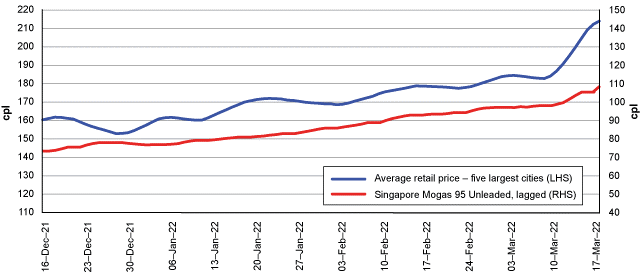Fuel prices are rising at their fastest pace in years, leaving motorists feeling the bite at the bowser.
Petrol prices are highest in Hobart, Brisbane and Adelaide, however nowhere has been immune.
The Australian Competition and Consumer Commission’s (ACCC) petrol monitoring report showed February prices in Australia’s five largest cities had risen to an eight-year high.
The average price of petrol across Australia at the end of March is 206.7 cents per litre, according to the Australian Institute of Petroleum (AIP), which is almost 50 cents more than the average of 159.3 cents in the past 12 months.
In Western Australia, the RAC has calculated that if petrol were to average $2.20 per litre throughout 2022, the average motorist would be forced to pay an additional $908 to keep their car on the road.
That figure would soar to $1150 extra if petrol averages at $2.40 per litre.
There’s no doubt the recent international conflict has pushed up crude oil prices. But what else is behind the price rise?
Breaking down the pump price
To understand what’s behind the price rise, we need to first look at the factors determining the price of fuel.
The pump price is more complex than you may think. When you break it down, the price is made up of:
o Australian taxes: That includes 10% GST and over 44 cents per litre in excise duty.
o Production and shipping costs to Australia and fuel sites
o Wholesaler and retailer margin, which includes staff and operating costs, leases, distribution, and other costs. On top of this, wholesalers and retailers need to make a profit if they want to make their businesses viable.
Let’s explore these in more detail.
The role of Government taxes and levies
A substantial cost of each litre of fuel drivers pay is made up of taxes and levies.
For petrol and diesel, this includes GST and excise tax.
Excise rates on fuel and petroleum products (except aviation fuels) are indexed twice a year in line with the consumer price index (CPI).
For unleaded petrol (regular or premium grades) and diesel, the pump price includes Australian Government fuel excise at 44.2 cents per litre (as at February 2022). This raises around $11 million per year, which is largely reinvested in roads and transport.
In the Federal Budget 2022 speech on 29 March, the Government announced a 50% cut in the fuel excise of 22 cents in the litre, which amounts to a saving of around $15 on the average price of a tank of petrol.
The cut is expected to come into place in the next two weeks and remain for six months.
The last time the fuel excise was cut in Australia was in 2001 when John Howard reduced it by 1.5 cents.
The role of the global market
For petrol and diesel, the largest component of the price drivers pay comes down to the international benchmark price.
That means prices for fuels sold in Australia follow these benchmarks:
- Regular Unleaded Petrol – Singapore Mogas 95 Unleaded (see below chart)
- Diesel – Singapore Gasoil 10 parts per million sulphur
Source: ACCC
As well as changes in international benchmark prices, fuel prices in Australia can go up and down due to:
o the value of the Australian dollar relative to the US dollar – all countries pay for fuel in United States dollars.
o levels of competition in different areas.
Because we are part of the global market, the price of fuel is impacted by global events.
Right now, the Organisation of Petroleum Exporting Countries (OPEC), which is the world’s largest supplier of oil, is restricting its supply of oil onto world markets.
The COVID-19 pandemic fuelled supply chain issues. Then, more recently, Russia’s invasion of Ukraine means exports have dwindled, which means there’s more demand for fuel from other regions.
As a result, the price of Brent crude oil – the global benchmark for oil costs – has soared, and that affects the pump price.
Sometimes fuel retailers can absorb costs, but these are simply too high and if they are going to cover their operating costs and make any profit, they need to increase the pump price.
Conclusion
Pump prices depend on a huge range of factors. So long as the conflict in Ukraine continues, drivers in Australia – as in other countries – can expect fuel prices to keep climbing. However, the fuel excise reduction announced on March 29 will go some way to helping drivers manage higher costs.
The fuel cards offered by Business Fuel Cards can also provide discounts at the pump, streamline business financial requirements, and ensure your business has visibility across all of your fleet behaviour.
Get more market insights and trends as they happen – follow us on LinkedIn.

